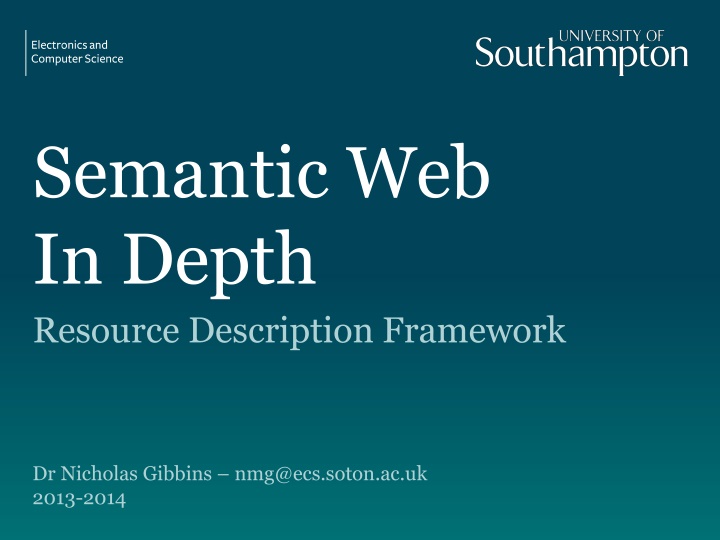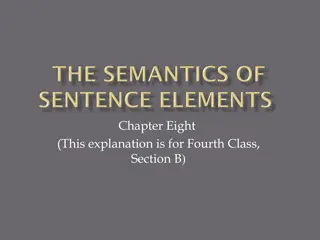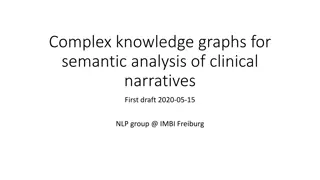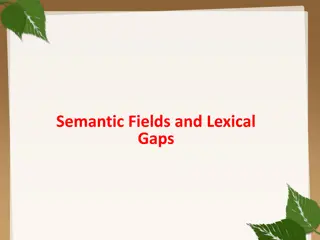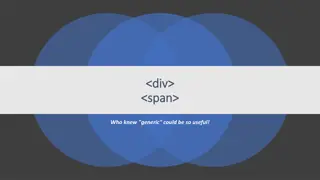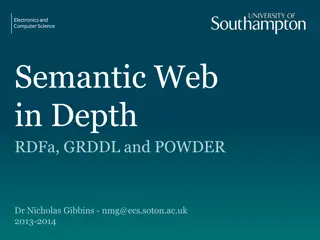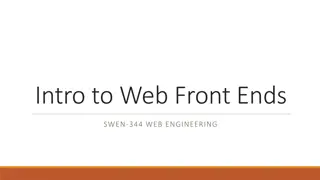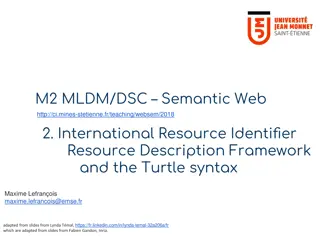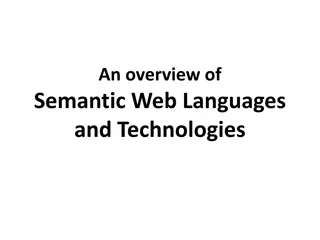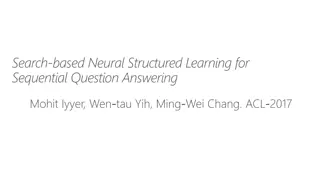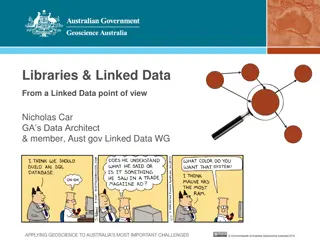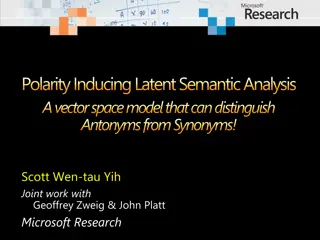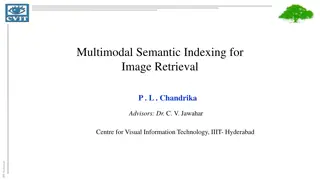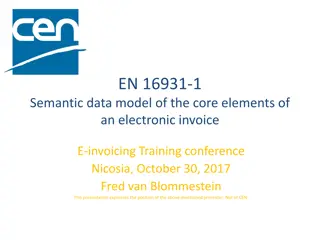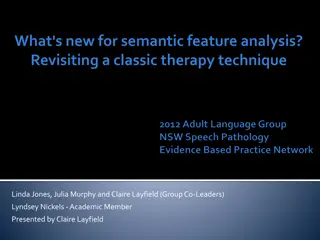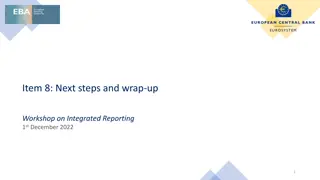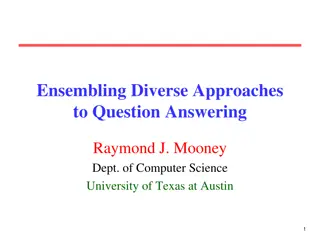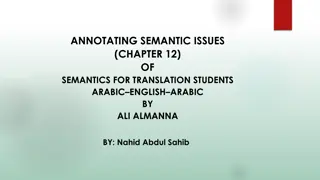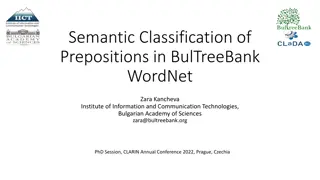Semantic Web In Depth
The Resource Description Framework (RDF) serves as a standard data model for the Semantic Web, utilizing subject-predicate-object triples as its primary representation. RDF allows for the expression of knowledge in various formats and notations, facilitating interoperability and data exchange on the web. The framework encompasses a family of data formats, a knowledge representation language, and establishes requirements for identifying objects and vocabulary terms, among other key functionalities.
Download Presentation

Please find below an Image/Link to download the presentation.
The content on the website is provided AS IS for your information and personal use only. It may not be sold, licensed, or shared on other websites without obtaining consent from the author.If you encounter any issues during the download, it is possible that the publisher has removed the file from their server.
You are allowed to download the files provided on this website for personal or commercial use, subject to the condition that they are used lawfully. All files are the property of their respective owners.
The content on the website is provided AS IS for your information and personal use only. It may not be sold, licensed, or shared on other websites without obtaining consent from the author.
E N D
Presentation Transcript
Semantic Web In Depth Resource Description Framework Dr Nicholas Gibbins nmg@ecs.soton.ac.uk 2013-2014
What is the Resource Description Framework? A standard data model for the Semantic Web A knowledge representation language A family of data formats and notations
A standard data model Recall that the Semantic Web uses subject-predicate-object triples as its standard representation: edited by RDF Semantics Pat Hayes subject predicate object This data model is independent of the syntax used to express (serialise) those triples.
A knowledge representation language RDF is used as the foundation for the other knowledge representation and ontology languages on the Semantic Web User Interface and Applications Trust Proof OWL Rules Encryption SPARQL (queries) Signature RDF Schema RDF XML + Namespaces URI Unicode
A family of data formats RDF/XML is the normative (standard) syntax Supported by almost all tools RDF/N3 (Notation3) is also widely used Non-XML syntax Variable tool support Primarily designed to be easy to write on whiteboards Other XML and non-XML syntaxes exist: Turtle, NTriples, TriX etc
RDF requirements A means for identifying objects and vocabulary terms (URIs) A means for distinguishing between terms from different vocabularies (XML namespaces and qualified names) A means for serialising triples (XML)
URIs and URIrefs Standard identifiers for the Semantic Web Uniform Resource Identifiers are defined by RFC2396 http://example.org/ urn:isbn:0198537379 mailto:nmg@ecs.soton.ac.uk URI references (URIrefs) are URIs with optional fragment identifiers http://example.org/index.html#Introduction http://www.w3.org/1999/02/22-rdf-syntax-ns#type
XML namespaces and qualified names RDF uses XML namespaces to refer to elements of domain vocabularies xmlns:rdf= http://www.w3.org/1999/02/22-rdf-syntax- ns# namespace abbreviation namespace URI prefix Namespaces used to abbreviate URIrefs to qualified names (QNames) http://www.w3.org/1999/02/22-rdf-syntax-ns#type becomes rdf:type QNames cannot be used in attribute values in RDF/XML Use the URIref instead
RDF/XML RDF/XML is an XML-based format for expressing a collection of RDF triples (an RDF graph) Can be parsed by an XML parser to give an XML data model (Document Object Model, XML Infoset) Can be parsed by an RDF parser to give an RDF data model (an RDF graph)
The anatomy of an RDF/XML file XML declaration RDF document element RDF namespace declaration Other namespace declarations Triple subject Triple predicate Triple object <?xml version= 1.0 ?> <?xml version= 1.0 ?> <rdf:RDF <rdf:RDF xmlns:rdf= http://www.w3.org/1999/02/22-rdf-syntax-ns# <rdf:RDF xmlns:rdf= http://www.w3.org/1999/02/22-rdf-syntax-ns# xmlns:dc= http://purl.org/dc/elements/1.1/ > <rdf:Description rdf:about= http://www.sciam.com/ > </rdf:Description> </rdf:RDF> </rdf:RDF> </rdf:RDF> </rdf:RDF> <?xml version= 1.0 ?> <?xml version= 1.0 ?> <?xml version= 1.0 ?> <rdf:RDF xmlns:rdf= http://www.w3.org/1999/02/22-rdf-syntax-ns# xmlns:dc= http://purl.org/dc/elements/1.1/ > xmlns:dc= http://purl.org/dc/elements/1.1/ > <rdf:Description rdf:about= http://www.sciam.com/ > </rdf:Description> </rdf:Description> </rdf:Description> <?xml version= 1.0 ?> <rdf:RDF xmlns:rdf= http://www.w3.org/1999/02/22-rdf-syntax-ns# <rdf:RDF xmlns:rdf= http://www.w3.org/1999/02/22-rdf-syntax-ns# xmlns:dc= http://purl.org/dc/elements/1.1/ > <rdf:Description rdf:about= http://www.sciam.com/ > <dc:title> </dc:title> <dc:title>Scientific American</dc:title> <?xml version= 1.0 ?> <?xml version= 1.0 ?> <rdf:RDF xmlns:rdf= http://www.w3.org/1999/02/22-rdf-syntax-ns# xmlns:dc= http://purl.org/dc/elements/1.1/ > <rdf:Description rdf:about= http://www.sciam.com/ > </rdf:RDF> </rdf:RDF> </rdf:RDF> Scientific American http://www.sciam.com/ http://purl.org/dc/elements/1.1/title
The anatomy of an RDF/XML file Resource-valued predicates use the rdf:resource attribute <?xml version= 1.0 ?> <rdf:RDF xmlns:rdf= http://www.w3.org/1999/02/22-rdf-syntax-ns# xmlns:dc= http://purl.org/dc/elements/1.1/ > <rdf:Description rdf:about= http://www.example.org/ > <dc:creator rdf:resource= mailto:john@example.org /> </rdf:Description> </rdf:RDF> http://www.example.org/ mailto:john@example.org http://purl.org/dc/elements/1.1/creator
The anatomy of an RDF/XML file We can have multiple rdf:Description elements within an rdf:RDF element <?xml version= 1.0 ?> <rdf:RDF xmlns:rdf= http://www.w3.org/1999/02/22-rdf-syntax-ns# xmlns:dc= http://purl.org/dc/elements/1.1/ > <rdf:Description rdf:about= http://www.example.org/ > <dc:title>Example Inc. Homepage</dc:title> </rdf:Description> <rdf:Description rdf:about= http://www.example.org/ > <dc:creator rdf:resource= mailto:john@example.org /> </rdf:Description> </rdf:RDF> http://purl.org/dc/elements/1.1/creator mailto:john@example.org http://www.example.org/ Example Inc. Homepage http://purl.org/dc/elements/1.1/title
The anatomy of an RDF/XML file We can have multiple predicates within an rdf:Description element <?xml version= 1.0 ?> <rdf:RDF xmlns:rdf= http://www.w3.org/1999/02/22-rdf-syntax-ns# xmlns:dc= http://purl.org/dc/elements/1.1/ > <rdf:Description rdf:about= http://www.example.org/ > <dc:title>Example Inc. Homepage</dc:title> <dc:creator rdf:resource= mailto:john@example.org /> </rdf:Description> </rdf:RDF> http://purl.org/dc/elements/1.1/creator mailto:john@example.org http://www.example.org/ Example Inc. Homepage http://purl.org/dc/elements/1.1/title
Class membership An object s membership of a class is indicated using the rdf:type property <?xml version= 1.0 ?> <rdf:RDF xmlns:rdf= http://www.w3.org/1999/02/22-rdf-syntax-ns# > <rdf:Description rdf:about= http://www.example.org/ > <rdf:type rdf:resource= http://example.org/ontology#Website /> </rdf:Description> </rdf:RDF> rdf:type http://www.example.org/ ex:Website
Abbreviated forms class membership Replace rdf:Description with QName of class <?xml version= 1.0 ?> <rdf:RDF xmlns:rdf= http://www.w3.org/1999/02/22-rdf-syntax-ns# xmlns:ex= http://example.org/ontology# > <ex:Website rdf:about= http://www.example.org/ /> </rdf:RDF> rdf:type http://www.example.org/ ex:Website
RDF/XML striped syntax Consider the following graph: http://www.example.org/ http://purl.org/dc/elements/1.1/creator mailto:john@example.org http://example.org/ontology#name John Smith
RDF/XML striped syntax Graph could be serialised using two rdf:Description elements <?xml version= 1.0 ?> <rdf:RDF xmlns:rdf= http://www.w3.org/1999/02/22-rdf-syntax-ns# xmlns:dc= http://purl.org/dc/elements/1.1/ xmlns:ex= http://example.org/ontology# > <rdf:Description rdf:about= http://www.example.org/ > <dc:creator rdf:resource= mailto:john@example.org /> </rdf:Description> <rdf:Description rdf:about= mailto:john@example.org > <ex:name>John Smith</ex:name> </rdf:Description> </rdf:RDF>
RDF/XML striped syntax Alternatively, the second statement could be inserted within the predicate element of the first <?xml version= 1.0 ?> <rdf:RDF xmlns:rdf= http://www.w3.org/1999/02/22-rdf-syntax-ns# xmlns:dc= http://purl.org/dc/elements/1.1/ xmlns:ex= http://example.org/ontology# > <rdf:Description rdf:about= http://www.example.org/ > <dc:creator> <rdf:Description rdf:about= mailto:john@example.org > <ex:name>John Smith</ex:name> </rdf:Description> </dc:creator> </rdf:Description> </rdf:RDF>
RDF/XML striped syntax The syntax is striped because property and class elements are nested alternately <?xml version= 1.0 ?> <rdf:RDF xmlns:rdf= http://www.w3.org/1999/02/22-rdf-syntax-ns# xmlns:dc= http://purl.org/dc/elements/1.1/ xmlns:ex= http://example.org/ontology# > <rdf:Description rdf:about= http://www.example.org/ > <dc:creator> <rdf:Description rdf:about= mailto:john@example.org > <ex:name>John Smith</ex:name> </rdf:Description> </dc:creator> </rdf:Description> </rdf:RDF> </rdf:RDF> <?xml version= 1.0 ?> <rdf:RDF xmlns:rdf= http://www.w3.org/1999/02/22-rdf-syntax-ns# xmlns:dc= http://purl.org/dc/elements/1.1/ xmlns:ex= http://example.org/ontology# > <rdf:Description rdf:about= http://www.example.org/ > <dc:creator> <rdf:Description rdf:about= mailto:john@example.org > <ex:name>John Smith</ex:name> </rdf:Description> </dc:creator> </rdf:Description>
Common RDF/XML idioms XML entities are defined for the XML namespace URI prefixes <?xml version= 1.0 ?> <!DOCTYPE rdf:RDF [ <!ENTITY rdf http://www.w3.org/1999/02/22-rdf-syntax-ns# > <!ENTITY dc http://purl.org/dc/elements/1.1/ > <!ENTITY ex http://example.org/ontology# > ]> <rdf:RDF xmlns:rdf= &rdf; xmlns:dc= &dc; xmlns:ex= &ex; > Used to abbreviate long URIrefs in attribute values (because QNames can t be used there)
Common RDF idioms Assertions about the null URIref are about the RDF file itself <?xml version= 1.0 ?> <rdf:RDF xmlns:rdf= http://www.w3.org/1999/02/22-rdf-syntax-ns# xmlns:dc= http://purl.org/dc/elements/1.1/ > <rdf:Description rdf:about= > <dc:creator rdf:resource= mailto:nmg@ecs.soton.ac.uk /> </rdf:Description> </rdf:RDF>
Blank nodes (bNodes) Sometimes we have resources which we do not wish to identify with a URI These are blank nodes or anonymous resources http://www.example.org/ http://purl.org/dc/elements/1.1/creator http://example.org/ontology#name John Smith
Blank nodes (bNodes) The striped syntax simplifies the RDF/XML serialisation remove the rdf:about attribute <?xml version= 1.0 ?> <rdf:RDF xmlns:rdf= http://www.w3.org/1999/02/22-rdf-syntax-ns# xmlns:dc= http://purl.org/dc/elements/1.1/ xmlns:ex= http://example.org/ontology# > <rdf:Description rdf:about= http://www.example.org/ > <dc:creator> <rdf:Description> <ex:name>John Smith</ex:name> </rdf:Description> </dc:creator> </rdf:Description> </rdf:RDF>
Blank nodes (bNodes) The striped syntax is not sufficient to represent all graphs containing blank nodes unambiguously dc:creator http://www.example.org/ John Smith ex:name http://test.example.org/ dc:creator
Blank nodes (bNodes) <?xml version= 1.0 ?> <rdf:RDF xmlns:rdf= http://www.w3.org/1999/02/22-rdf-syntax-ns# xmlns:dc= http://purl.org/dc/elements/1.1/ xmlns:ex= http://example.org/ontology# > <rdf:Description rdf:about= http://www.example.org/ > <dc:creator> <rdf:Description> <ex:name>John Smith</ex:name> </rdf:Description> </dc:creator> </rdf:Description> <rdf:Description rdf:about= http://test.example.org/ > <dc:creator> <rdf:Description> <ex:name>John Smith</ex:name> </rdf:Description> </dc:creator> </rdf:Description> </rdf:RDF>
Blank nodes and node IDs Ambiguities resulting from blank nodes are resolved by using node IDs Node IDs are identifiers which are local to a given serialisation of an RDF graph Node IDs may not be referred to from outside the scope of the defining graph Node IDs are not guaranteed to remain unchanged when an RDF file is parsed and serialised The identifier strings may change but The graph structure will remain unchanged
Blank nodes and node IDs <?xml version= 1.0 ?> <rdf:RDF xmlns:rdf= http://www.w3.org/1999/02/22-rdf-syntax-ns# xmlns:dc= http://purl.org/dc/elements/1.1/ xmlns:ex= http://example.org/ontology# > <rdf:Description rdf:about= http://www.example.org/ > <dc:creator rdf:nodeID= foo23 /> </rdf:Description> <rdf:Description rdf:about= http://test.example.org/ > <dc:creator rdf:nodeID= foo23 /> </rdf:Description> <rdf:Description rdf:nodeID= foo23 > <ex:name>John Smith</ex:name> </rdf:Description> </rdf:RDF>
rdf:about versus rdf:ID So far, we have used the rdf:about attribute to specify the subjects of triples rdf:about takes a URIref as a value rdf:ID can be used to declare a new URIref within a document Within the file http://www.example.org/ontology <rdf:Description rdf:ID= JohnSmith > declares a new URIref http://www.example.org/ontology#JohnSmith Analogous to the name and id attributes in HTML Relative to xml:base attribute
Datatypes Literal values presented so far are plain and do not have a type Many applications need to be able to distinguish between different typed literals RDF uses XML Schema datatypes <rdf:Description rdf:about= http://www.example.org/ > <dc:date rdf:datatype= http://www.w3.org/2001/XMLSchema#date >2003-05-23</dc:date> </rdf:Description>
Multilingual support In addition to typed literals, RDF also provides support for language annotations on literals RDF uses XML s multilingual support <?xml version= 1.0 ?> <rdf:RDF xmlns:rdf= http://www.w3.org/1999/02/22-rdf-syntax-ns# xmlns:dc= http://purl.org/dc/elements/1.1/ > <rdf:Description rdf:about= http://www.example.org/foreword > <dc:title xml:lang= en >Foreword</dc:title> <dc:title xml:lang= fr >Avant-propos</dc:title> </rdf:Description> </rdf:RDF> Languages identified by ISO369 two letter codes
Containers RDF provides means for describing groups of objects Membership in the group is denoted by the ordinal properties rdf:_1, rdf:_2, etc rdf:Bag mailto:john@example.org rdf:_1 rdf:type rdf:_2 http://www.example.org/ mailto:bill@example.org ex:members rdf:_3 mailto:sally@example.org
Containers Three types of container are available in RDF rdf:Bag an unordered group, possibly with duplicates rdf:Seq an ordered group rdf:Alt a group of alternatives (translations, media types, etc)
Containers Special syntax for expressing collections rdf:li is a convenience element which is replaced with ordinal elements by RDF parsers <?xml version= 1.0 ?> <rdf:RDF xmlns:rdf= http://www.w3.org/1999/02/22-rdf-syntax-ns# xmlns:ex= http://example.org/ontology# > <rdf:Description rdf:about= http://www.example.org/ > <ex:members> <rdf:Bag> <rdf:li rdf:resource= mailto:john@example.org /> <rdf:li rdf:resource= mailto:bill@example.org /> <rdf:li rdf:resource= mailto:sally@example.org /> </rdf:Bag> </ex:members> </rdf:Description> </rdf:RDF>
Collections Collections are a different way of expressing ordered groups in RDF Containers are mutable a third party could add new members to a container Collections are immutable cannot be altered without rendering the collection ill-formed Similar to cons/car/cdr lists in Lisp
Collections rdf:Lis t ex:members rdf:type rdf:first mailto:john@example.org http://www.example.org/ rdf:rest rdf:first mailto:bill@example.org rdf:rest rdf:first mailto:sally@example.org rdf:rest rdf:nil
Collections As before, special syntax for expressing collections rdf:parseType indicates special parse rules for an element <?xml version= 1.0 ?> <rdf:RDF xmlns:rdf= http://www.w3.org/1999/02/22-rdf-syntax-ns# xmlns:ex= http://example.org/ontology# > <rdf:Description rdf:about= http://www.example.org/ > <ex:members rdf:parseType= Collection > <rdf:Description rdf:about= mailto:john@example.org /> <rdf:Description rdf:about= mailto:bill@example.org /> <rdf:Description rdf:about= mailto:sally@example.org /> </ex:members> </rdf:Description> </rdf:RDF>
The anatomy of an NTriples file <http://www.sciam.com/> <http://purl.org/dc/elements/1.1/title> Scientific American . Scientific American http://www.sciam.com/ http://purl.org/dc/elements/1.1/title
The anatomy of an Turtle/N3 file <http://www.example.org> <http://purl.org/dc/elements/1.1/creator> <mailto:john@example.org> ; <http://purl.org/dc/elements/1.1/title> Example Inc. Homepage . ; allows grouping of triples with common subject http://purl.org/dc/elements/1.1/creator mailto:john@example.org http://www.example.org/ Example Inc. Homepage http://purl.org/dc/elements/1.1/title
Common RDF/N3 idioms @prefix used to introduce QName abbreviations to N3 and Turtle documents: @prefix rdf: <http://www.w3.org/1999/02/22-rdf-syntax-ns#> . @prefix dc: <http://purl.org/dc/elements/1.1/> . @prefix ex: <http://example.org/ontology#> . <http://www.example.org> dc:creator <mailto:john@example.org> ; rdf:type ex:Website .
bNodes in N3 and Turtle <http://www.example.org/> dc:creator [ ex:name John Smith ] . Or with nodeIDs: <http://www.example.org/> dc:creator _:foo23 . <http://test.example.org/> dc:creator _:foo23 . _:foo23 ex:name John Smith .
RDF Status Original version published in 1999 Working group (RDF Core) formed in April 2001 Revised version published in early 2004 New RDF working group chartered in 2011 (runs until 2013) New standard syntaxes (Turtle, JSON) Multiple graphs and graph stores
RDF references RDF homepage at W3C http://www.w3.org/RDF/ RDF Core Working Group homepage http://www.w3.org/2001/sw/RDFCore/ RDF Working Group homepage http://www.w3.org/2011/rdf-wg/ RDF/N3 Primer http://www.w3.org/2000/10/swap/Primer.html XML Schema Part 2: Datatypes http://www.w3.org/TR/xmlschema-2/
